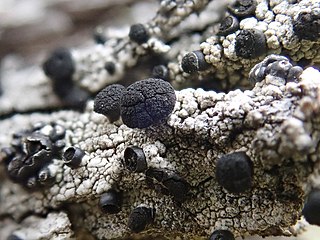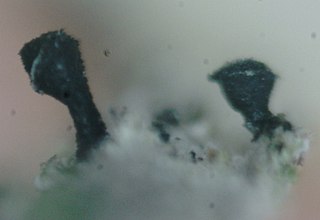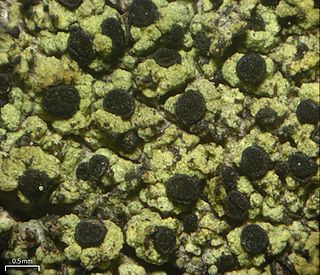
Calicium is a genus of leprose lichens. It is in the family Caliciaceae, and has 40 species.

Acolium is a genus of lichenized fungi in the family Caliciaceae. The genus has a widespread distribution and contains six species. These lichens are found on bark and wood, occasionally on rocks, or growing on other lichens.

Roccella is a genus of 23 species of lichens in the family Roccellaceae. The genus was circumscribed by Swiss botanist Augustin Pyramus de Candolle in 1805, with Roccella fuciformis as the type species.

The Caliciaceae are a family of mostly lichen-forming fungi belonging to the class Lecanoromycetes in the division Ascomycota. Although the family has had its classification changed several times throughout its taxonomic history, the use of modern molecular phylogenetic methods have helped to establish its current placement in the order Caliciales. Caliciaceae contains 39 genera and about 670 species. The largest genus is Buellia, with around 300 species; there are more than a dozen genera that contain only a single species.

Pilophorus acicularis, commonly known as the nail lichen or the devil's matchstick lichen, is a species of matchstick lichen in the family Cladoniaceae.
Calicium sequoiae is a crustose lichen that has only been found growing on old-growth redwood trees in California. It is a species of pin lichen in the family Caliciaceae. Apothecia are white-powder coated (pruinose). The unusual spores have spiral ridges.

Calicium abietinum, commonly known as fir pin or black stubble, is a crustose lichen that is found growing on trees throughout much of the world.
Calicium chlorosporum is a crustose lichen that is found growing on trees throughout much of the world.

Calicium glaucellum is a crustose lichen that is found growing on trees throughout much of the world. The species is similar to Calicium abietinum.

Allocalicium is a single-species fungal genus in the family Caliciaceae. It is monotypic, containing the single pin lichen species Allocalicium adaequatum. This lichen occurs in North America, South America, Europe, and the Russian Far East, where it grows on branches and twigs of deciduous trees and shrubs, typically those of alder and poplar. The species was originally described in 1869 as a member of Calicium, but molecular phylogenetics analysis demonstrated it was not a member of that genus and so Allocalicium was created to contain it.

Pseudothelomma is a genus of crustose pin lichens in the family Caliciaceae. It currently contains two species. The genus was circumscribed in 2016 by lichenologists Maria Prieto and Mats Wedin. The generic name Pseudothelomma refers to its resemblance to the genus Thelomma, where the two species used to be classified. Both species grow on dry exposed wood, particularly fence posts.

Calicium trabinellum, commonly known as the yellow-collar stubble lichen, is a widespread species of pin lichen in the family Caliciaceae. It was first described by Swedish lichenologist Erik Acharius in 1803 as Calicium xylonellum ß trabinellum. He made the new combination Calicium trabinellum in a later chapter of the same publication.
Calicium episcalare is a rare species of pin lichen that is known from only a single locality in Sweden. It is in the family Caliciaceae. It one of the few Calicium species that is parasitic on another lichen. The type was found growing on the north-facing wall of an old wooden barn in Dalsland. The barn, which dates to the 17th century, was made from old pine wood and had likely never been painted. The specific epithet episcalare refers to the name of the host, Hypocenomyce scalaris, a common and widespread lichen. Calicium episcalare was described as a new species in 2016 by Swedish lichenologists Leif Tibell and Tommy Knutsson.

Calicium pinicola is a species of lignicolous (wood-dwelling), crustose lichen in the family Caliciaceae. It is widely distributed in Europe, and also occurs in the United States.
Placomaronea minima is a species of saxicolous (rock-dwelling) crustose lichen in the family Candelariaceae. Found in South America and Southern Africa, it was formally described as a new species in 2009 by lichenologists Martin Westberg and Patrik Frödén. The type specimen was collected by the second author from the Santiago Metropolitan Region (Chile) at an altitude of about 1,200 m (3,900 ft), where it was found growing on rocks on a hill outside of San José de Maipo. The species epithet minima refers to its small size.

Calicium corynellum is a species of pin lichen in the family Caliciaceae. It is found scattered across parts of Europe, North America, and Asia, where it grows on rock surfaces in shaded and humid locations.

Pyrenodesmia variabilis is a species of saxicolous (rock-dwelling), crustose lichen in the family Teloschistaceae. Characteristics of the species include its dark, areolate thallus, and its dark, sessile (stalkless) apothecia. It occurs on nutrient-rich limestone surfaces in Northern Europe, North America, Central America, and Asia.

Pseudothelomma ocellatum is a species of lignicolous (wood-dwelling), crustose lichen in the family Caliciaceae. This lichen is characterised by its grey, areolate thallus that produces abundant lichenised diaspores, such as short spherical isidia and coarse, dark brown-black soredia. It is typically sterile, meaning apothecia are absent.

Pseudothelomma occidentale is a species of corticolous (bark-dwelling), crustose lichen in the family Caliciaceae. It was first formally described by Albert William Herre in 1910, who initially classified it in the genus Cyphelium. Leif Tibell transferred it to Thelomma in 1976. In 2016, María Prieto and Mats Wedin transferred the taxon to the newly circumscribed genus Pseudothelomma.
Fellhanera antennophora is a species of corticolous (bark-dwelling) crustose lichen in the family Pilocarpaceae. It occurs in Brazil.













